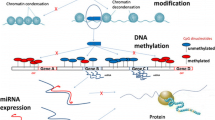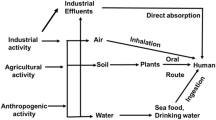Abstract
In liver microsomes of rats 5 h after intraperitoneal administration of bromobenzene, the activities of a series of drug-metabolizing mixed-function oxidases, i. e., ketamine and aminopyrine N-demethylases, methylayapanine and methoxybiphenyl O-demethylases, and ethoxycoumarin O-deethylase, as well as glutathione and cytochrome b5 contents were found to be decreased, whereas the activities of microsomal, NADPH-dependent cytochrome c and neotetrazolium reductases as well as cytochrome P-450 were unchanged.
Similar content being viewed by others
References
Aitio J (1978) A simple and sensitive assay of 7-ethoxycoumarin deethylation. Analyt Biochem 85: 488–491
Beyhl FE (1980a) Interaction of bromobenzene with hepatic microsomal drug-metabolizing enzymes in vitro. In: Abstracts of the International Conference on Xenobiochemistry, Bratislava (Czechoslovakia). Abstr. no. 10
Beyhl FE (1980b) Interaction of Zwittergent, a novel detergent, with microsomal drug-metabolizing mixed-function oxidases. In: Gustafsson J-Å, Carlstedt-Duke J, Mode A, Rafter J (eds) Biochemistry, biophysics and regulation of cytochrome P-450. Elsevier/North Holland Publishers, Amsterdam (Netherlands), pp 141–144
Beyhl FE (1981) Inhibition by sodium nitroprusside of microsomal drug oxidation. IRCS Med Sci 9: 998–999
Beyhl FE (1983) Use of ketamine as substrate for microsomal N-demethylating mixed-function oxidase determination. In: Abstracts of the 1st Cyprus Conference on New Methods in Drug Research, Limassol (Cyprus) p 10
Beyhl FE, Mayer DG (1980) Studies on liver toxicants. Influence of bromobenzene on hepatic microsomal enzymes in rats. Arch Toxicol 43: 257–262
Beyhl FE, Mayer DG (1981) Studies in liver toxicants. Influence of bromobenzene on hepatic microsomal enzymes in mice. Toxicol Lett 7: 481–485
Beyhl FE, Sinharay A (1980) Use of methylayapanine as a substrate for microsomal O-demethylase. In: Coon MJ, Conney AH, Estabrook RW, Gelboin HV, Gillette JR, O'Brien PJ (eds) Microsomes, drug oxidations, and chemical carcinogenesis. Academic Press, New York (USA) pp 111–114
Beyhl FE, Lindner E, Sinharay A (1982) Diphasic action of 2,2-diphenylpropionic acid N,N-diethylaminoethyl ester hydrochloride on hepatic drug metabolism in the mouse. Experientia 38: 1220–1222
Brodie BB, Reid W, Cho A, Sipes G, Krishna G, Gillette JR (1971) Possible mechanism of liver necrosis caused by aromatic organic compounds. Proc Natl Acad Sci USA 68: 160–164
Cleveland PD, Smuckler EA (1965) Effect of carbon tetrachloride, diethylnitrosamine, and thioacetamide on hepatic DPNH and TPNH cytochrome c reductases. Proc Soc Exp Biol Med 120: 808–810
Dallner G, Siekevitz P, Palade GE (1966) Biogenesis of endoplasmic reticulum membranes. II. Synthesis of constitutive microsomal enzymes in developing rat hepatocyte. J Cell Biol 30: 97–117
Ellman GL (1959) Tissue sulfhydryl groups. Arch Biochem Biophys 82: 70–77
Estabrook RW (1969) Discussion Remark. In: Gillette JR, Conney AH, Cosmides GJ, Estabrook RW, Fouts JR, Mannering GJ (eds) Microsomes and drug oxidations. Academic Press, New York (USA) p 149
Funck-Brentano C, Tivel M, Degott C, Letteron P, Barbany G, Pessayre D (1984) Protective effect of 16,16-dimethyl prostaglandin E2 on the hepatotoxicity of bromobenzene in mice. Biochem Pharmacol 33: 89–96
Garfinkel D (1958) Studies on pig liver microsomes. I. Enzymic and pigment composition of different microsomal fractions. Arch Biochem Biophys 77: 493–509
Hesse S, Wolff T, Mezger M (1979) Involvement of phenolic metabolites in the irreversible protein binding of 14C-bromobenzene catalyzed by rat liver microsomes. In: Abstracts of the 21st Congress of the European Society of Toxicology, Dresden (GDR), Abstr. no. 130
Johannesen KAM, De Pierre JW (1978) Measurement of cytochrome P-450 in the presence of large amounts of contaminating hemoglobin and methemoglobin. Anal Biochem 86: 725–732
Jollow DJ, Mitchell JR, Zampaglione N, Gillette JR (1974) Bromobenzene-induced liver necrosis. Protective role of glutathione and evidence for 3,4-bromobenzene oxide as the hepatotoxic metabolite. Pharmacology 11: 151–169
Klingenberg M (1958) Pigments of rat liver microsomes. Arch Biochem Biophys 75: 376–386
Leber HW, Degkwitz E, Staudinger H (1969) Untersuchungen zum Einfluß der Ascorbinsäure auf die Aktivität und die Biosynthese mischfunktioneller Oxygenasen sowie den Gehalt an Hämoproteiden in der Mikrosomenfraktion der Meerschweinchenleber. Hoppe-Seyler's Z Physiol Chem 350: 439–445
Lester RI, Smith AL (1961) Studies on the electron transport system. — XXVIII. The mode of reduction of tetrazolium salts by beef heart mitochondria; role of coenzyme Q and other lipids. Biochim Biophys Acta 47: 475–496
Mayer DG, Beyhl FE (1983) Studies on liver toxicants. Influence of bromobenzene on hepatic microsomal drug-metabolizing enzymes in the hamster. Toxicol Lett 16: 89–94
Omura T, Sato R (1964) The carbon-monoxide-binding pigment of liver microsomes. II. Solubilization, purification, and properties. J Biol Chem 239: 2379–2385
Potter VR, Elvehjem CA (1936) A modified method for the study of tissue oxidation. J Biol Chem 114: 495–504
Reid WD, Krishna G, Gillette JR, Brodie BB (1973) Biochemical mechanism of hepatic necrosis induced by aromatic hydrocarbons. Pharmacology 10: 193–214
Sasame HA, Castro JA, Gillette JR (1968) Studies on the destruction of liver microsomal cytochrome P-450 by carbon tetrachloride administration. Biochem Pharmacol 17: 1759–1768
Schenkman JB, Cinti DL (1972) Hepatic mixed function oxidase activity in rapidly prepared microsomes. Life Sci 11: 247–257
Schoene B, Fleischmann RA, Remmer H, Von Oldershausen HF (1972) Determination of drug metabolizing enzymes in needle biopsies of human liver. Eur J Clin Pharm 4: 65–73
Thor H, Moldéus P, Danell N, Orrhenius S (1979) Isolated liver cells for the study of drug toxicity. In: Estabrook RW, Lindenlaub E (eds) The induction of drug metabolism. Symposia Medica Hoechst 14. Schattauer, Stuttgart, pp 355–371
Van Doorn R, Bos RP, Brouns ME, Lejdekker C-M, Henderson PT (1980) Effect of toluene and xylenes on liver glutathione and their urinary excretion as mercapturic acids in the rat. Arch Toxicol 43: 293–304
Zampaglione N, Jollow DJ, Mitchell JR, Stripps B, Hamrick M, Gillette JR (1973) Role of detoxifying enzymes in bromobenzene-induced liver necrosis. J Pharmacol Exp Ther 187: 218–227
Author information
Authors and Affiliations
Additional information
Dedicated to Professor Dr. med. Herbert Remmer on the occasion of his 65th Birthday
Rights and permissions
About this article
Cite this article
Beyhl, F.E., Mayer, D.G. Studies on liver toxicants. Arch Toxicol 60, 109–111 (1987). https://doi.org/10.1007/BF00296960
Issue Date:
DOI: https://doi.org/10.1007/BF00296960




